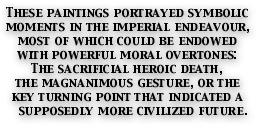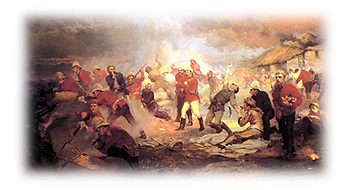| In the Eighteenth Century there was a strict hierarchy of seniority or respectability in painting. At the head was 'history' painting which was concerned with the portrayal of classical events or scenes from mythology and the Bible. It had been extended to cover Celtic images and moments from the remote British past, but later in the century imperial events were to transform history painting into a field that could concern itself with contemporary times.
Painters began to discover in moments of high imperial drama scenes that could be recreated, embellished, and heightened in a myth-making form. The geographical remoteness of the empire provided an acceptable alternative to the chronological remoteness of the old themes of history painting and exotic surroundings - the landscapes, buildings, and animals - offered stimulating contexts. Above all, the larger-than-life events could readily be incorporated into heroic myth.
Occasionally artists were present at the events they painted, but generally they were not. The paintings were mostly based on a combination of published or oral accounts and the re-imagining of events in epic terms. Except in the case of peripheral detail, artists were seldom accused of inaccuracy because spectators, including those who had been present at the events, were happy to be conspirators in the poetic truth of the heroic moment.
The first moment to receive this treatment was the death of General Wolfe on the heights of Abraham in 1759. the symbolic sacrifice for the British capture of Quebec. The treatment by the American artist Benjamin West (who later became the President of the British Royal Academy) hit the artistic headlines when displayed at the Academy in 1771. West was much criticized for putting actors in a history painting into modern dressm but nonetheless the form took hold of the artistic and public imagination. Subsequent history painters were able to create a more distancing effect by placing some fo the figures - Indians, Africans or other non-European people - into exotic dress.
The conventions of the imperial history painting had been swiftly established. The paintings portrayed symbolic moments in the imperial endeavour, most of which could be endowed with powerful moral overtones: The sacrificial heroic death, the magnanimous gesture, or the key turning point that indicated a supposedly more civilized future. They focused imperial endeavour on the heroic individual, creating highly personalized myths that continued to resonate with the public throughout much of the imperial period. These subjects were taken up again and again, both by a succession of artists and by engravers and illustrators of children's and popular works. In the late Nineteenth Century history paintings became models for tableaux vivants, in which live people re-enacted, in frozen dumb show, these striking moments. Thus some of them reached iconic status, providing images that many members of the British public could call to mind and them to justify imperial rule.
The tradition of history painting, with further subjects derived from naval battles and events such as the death of Nelson in the Napoleonic Wars and the Indian Rebellion of 1857, carried on throughout the Nineteenth Century. By the late Nineteenth Century, paintings of imperial campaigns had become almost commonplace, partly stimulated by the appointment of war artists and correspondents. Battle paintings ceased to be true history paintings. Henceforth they purported to be factual representations of actual events rather than embodiments of high moral sentiments.
Many of the images produced by the imperial artists of the Nineteenth Century reached a wider public through engravings in the illustrated journals. The Illustrated London News, founded in 1842, The Graphic, founded in 1862, and other illustrated newspapers contained large numbers of imperial images. In key years like 1879 - a year of war in South Africa and Afghanistan - the Illustrated London News seemed to contain little else. As well as the warfare and disasters of empire, significant events, such as the visit of the Prince of Wales to India in 1875-76, were commemorated in special editions. The iconography of contemporary history had by this time become a demotic art form.
|


